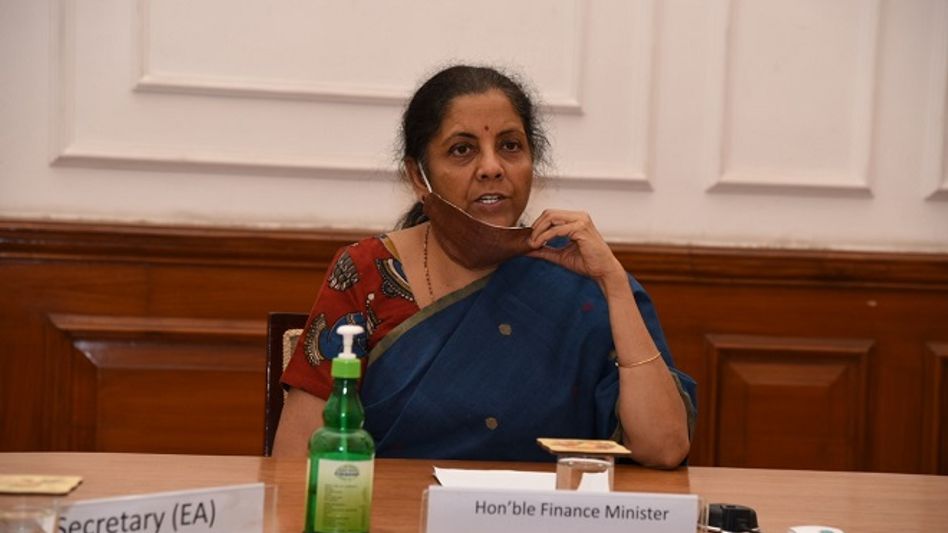For whom the FM announced the measures?
 Nirmala Sitharaman
Nirmala SitharamanThe most awaited announcements by the Finance Minister Nirmala Sitharaman came after Prime Minister Narendra Modi announced a Rs 20 lakh crore fiscal stimulus package to tackle the after-effects of the corona lockdown. The package is aimed for growth and self-reliance, hence the term ‘Atma Nirbhar Abhiyan’. While self-reliance with its Nehruvian connotations certainly hits a sweet spot, there are several nuances in the India of 2020 that limits such a utopia because of the contradictions that befall.
Let’s consider what those nuances are, and why the groups that were included and excluded in the most awaited press conference by the FM is the first disappointment in the fulfillment of those nuances.
Who was the FM talking to? As the press conference went on, it seemed as if the government is only talking to a handful of “organised” businesses. The section of the population that was in the urgent need of priority and relief namely the poor, informal and precarious migrant labour, the agricultural labour, the daily wage earner, and the self-employed were discussed in haste. Although, the FM said, "we shall not forget that we do have a responsibility towards the poor, needy, the migrants workers, divyang and the aged of the country" but the framework to tackle the crisis was not clearly laid out.
After the migrant exodus and the death toll of more than 30, who should have been the first priority?
Talking about the framework, let’s talk about MSMEs, one of the subjects at the press conference which was given utmost attention. The definition of MSMEs has been revised, investment limit to be revised upwards, additional criteria of turnover also being introduced.
MSMEs have tremendous potential to accelerate growth through the demographic dividend as it is labour intensive in nature, contributing almost 30% of GDP. It has both organised as well as unorganised units because small units sometimes find it costly to register themselves with the MSME act and hence operate as informal micro-enterprises. To present a picture, if there are 20 registered MSMEs, there are 100 unregistered SMEs, as per Small Industries Development Orgnaisation (SIDO) report. It is important to understand that unorganised and unregistered units are highest in the micro-segment, as per the Annual Report 2016-17 M/o MSME.
The ambiguity
Firstly it is unclear if the benefits extended by the FM go out to the unregistered enterprises as well? Second, what the new definitions may implicate is that unregistered micro-enterprises may find it difficult to compete with a micro-enterprise with an investment of Rs 1 crore and a turnover of Rs 5 crore. Third, the new definitions talk about an “and” rather than an “or” between investment and turnover criterion, which makes the criterion narrow in its own nature of classification. For example, the classification for Micro units is an investment of Rs 1 crore ‘and’ turnover of Rs 5 crore.
MSME and beyond
Covid-19 definitely brought a problem of liquidity and the FM was rightly guided to address it, yet the overarching crisis of the MSME sector growth remains unaddressed, of which labour laws are an integral one. In the debate of labour reforms, empirical as well as theoretical studies were done by Anamitra Roychowdhury and Kaushik Basu has shown that the “theoretical foundation of labour market flexibility is unsound” and that MSME growth is not constrained by labour law rigidity. A line of thought prevails that India's rigid labour laws and excessive regulations assumed to protect the labour are the cause of slow employment growth in high paying, organised sector. Is the government trying to facilitate this approach?
In recent events, we witnessed the revoking of labour laws in the states of Uttar Pradesh and Madhya Pradesh. What it essentially does is it lowers the purchasing power of the ultimate consumers and hence lowers the aggregate demand for mass consumption goods. It is this precise crisis that the whole Indian industrial sector faces as well. To explain, for any industrial sector to flourish, large or small or medium or micro, it needs a market, which is the market constraint. The market is born out of the food and non-food consumption expenditure, which is the demand constraint.
When these businesses don’t flourish, there is less revenue that goes to the government in the form of taxes and cess. The fiscal constraint gets tighter, while the government continues to provide electricity, water, and other inputs at subsidised costs. With a tight fiscal constraint, the government has less to give out in the form of food and fuel subsidies (DBT or PDS), which again lowers the consumer’s ability to spend. This further affects the demand constraint and reinforces the market constraint. Thus, it’s all a loop.
So, how does the FM plan to “grow” the MSME sector by only talking about liquidity issues and not at all talking about the main problems that haunt it? What about the demand constraint, set by the unemployment, labor, and an overarching agrarian crisis? If we have an unemployment rate of a 45 year old high, and even higher due to the effects of Covid-19, where is the demand going to come from? This comes at a time when the Supreme Court has directed the Assam government to reply on a plea seeking payment of wages and ration supplies to the tea garden workers.
If labour laws continue to be revoked and the majority of the demanding population grows vulnerable each day, where do we expect demand for mass consumption goods to come from? Or are we only talking to a handful (8-10% of the total workforce) of regular salaried organised sector workers?
Moreover, with the agricultural sector at a backlash, backward and forward linkages will be affected for MSMEs. The sole crisis of the Industrial sector stems from an unequal income distribution of the agricultural sector. The agricultural sector acts as an Achilles heel for the Industry for all the nuances explained above.
Also read: Over 50 migrant workers walk back to Assam from Haryana after thrown out by employers
Even if we talk about exports, firstly, with the situation of the global economy, MSMEs would need a lot more than liquidity backing to compete with the garment, textile and food-beverages industry of its East Asian neighbours like China, Indonesia, Vietnam, Bangladesh, etc. in order to thrive in a global value chains and accrue profits as well, they would need access to credit and insurance to risk, market information, reservations, tax cuts, and such other measures. Are we assuming MSME’s to not produce mass consumption goods but instead only produce semi-luxury and luxury goods?
Going forward
If we are truly to aim to be self-reliant, one must address the majority of the population, which is the agricultural labour and the migrant daily wage labour, the ones who should have been the first priority to address. We must aim for radical agricultural reforms, including land reforms.
The only relief some have received is from the Pradhan Mantri Garib Kalyan Yojana (PMGKY) through Direct Benefits Transfer (DBT) in their Jan Dhan Accounts. But the sole reliance on Jan Dhan accounts will turn out to be disastrous for the Indian macroeconomy because Jan Dhan accounts and Aadhar accounts are itself problematic as highlighted by several surveys that even 150 million people are excluded. Although financial inclusion has increased, there still remains other structural issues that need to be addressed.
Other than that, the Direct tax measures and the EPF measure beneficiaries are only a small minority (8% of the total workforce). If agricultural reforms that put the major size of demand on them are not done, then the market constraint, the demand constraint, and the fiscal constraint will always haunt the industrial sector in India, more so the SMEs. Hopefully, in the coming announcements, these nuances will be covered.
About the author: RAKTIMA KALITA is a contributing writer on labour and economy for InsideNE. She is currently enrolled in JNU. Views expressed in the article are that of the author.
Readers like you make Inside Northeast’s work possible.
To support our brand of fearless and investigative journalism, support us HERE.
Download:
The Inside Northeast app HERE for News, Views, and Reviews from Northeast India.
Do keep following us for news on-the-go. We deliver the Northeast.
Copyright©2025 Living Media India Limited. For reprint rights: Syndications Today









